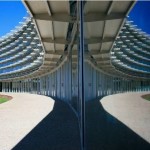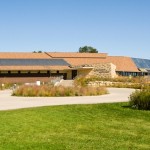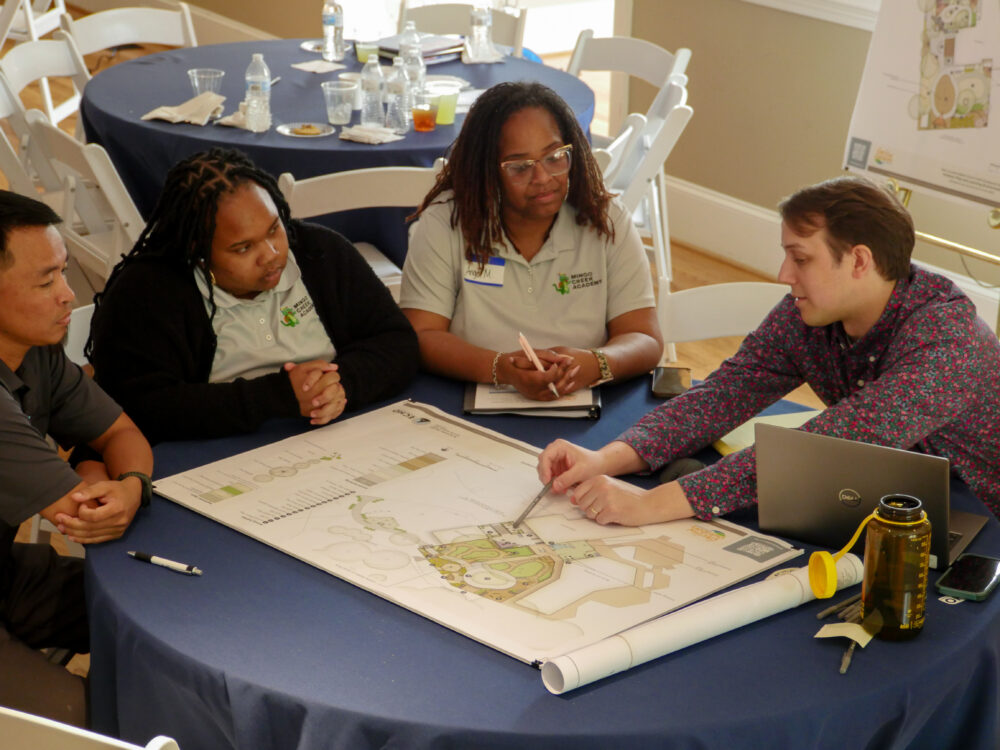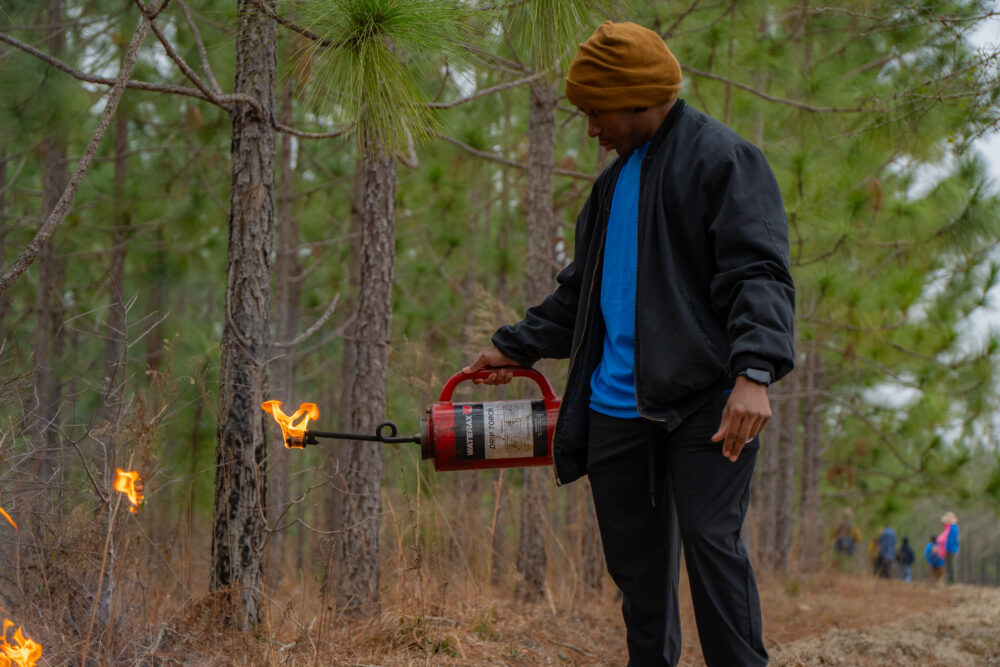We have much more to do and your continued support is needed now more than ever.
Learning from the Ancients: Passive Solar Design

November 18, 2009
Passive solar design techniques have been employed by humans for centuries, going back as far as first century Greeks who designed entire south-facing communities to give homes maximum access to the sun’s rays. But passive solar is experiencing a rebirth on geographically diverse campuses like the University of Wisconsin (UW), Northern Arizona University (NAU), and Oregon Health and Science University (OHSU), who are putting some new, efficient heating systems to shame.
The Arboretum Visitor Center at UW (Madison, Wisconsin) sits on a 1,200 acre plot of prairie restoration land. The original 1978 4,600 square foot construction project was furnished with a passive solar heating system that is still functioning today. And it’s a busy place, housing staff offices and serving as a public visitor center as well as an area for various student programs.
The Arboretum’s passive solar design consists of sealed glass panels that were installed on the roof, fitted with air-filled tubing that warms in the sun. The heated air is transferred indoors through insulated tubes and to a pebble bed on the lower level of the building. Then, using a simple system of ductwork and baffles (deflectors for directing airflow), the warm air is circulated from the pebble bed into the building throughout the day. The pebble bed even retains enough heat to provide some of the warming required on sunless days.
The pebble bed (which is supplemented by a conventional gas heating system) keeps the temperature indoors consistently comfortable and provides approximately 40 percent of the building’s heating requirements, depending in part on the harshness of the winter. During periods when heating is not required or during the summer, the system is shut off and vents are used to funnel warm air out of the building.
Even after more than 30 years, passive solar continues to provide low-energy heat for the occupants. And the maintenance requirements are next to none: “Sometimes one of the baffles gets stuck open or closed which results in uncomfortably high or low temperatures,” explains Molly Murray, outreach and education manager for the Arboretum, “but that only happens once every year or two.” The university maintains the system and un-sticking a baffle can be performed by almost any of those staff members.
However, when maintenance personnel unfamiliar with the system arrive to fix it, explaining the situation can be a challenge. Murray says, “It’s not technically difficult, just that it’s different. If someone comes out to check the furnaces and can’t see why we’re too hot, and they don’t know where the baffles are, they try to tell us that there’s nothing wrong with the furnace, even though the problem is with the baffles.”

Applying ancient designs to new buildings
But passive solar designs also exist in newer, more modern buildings. Institutions like NAU (Flagstaff, Arizona) are building passive solar designs into their new structures-at least four of them. “NAU is located at 7,000 feet and has exceptional solar radiance even during the coldest months of the winter,” explains Richard Bowen, assistant to the president and associate vice president for economic development and sustainability. “It only makes sense that we design our buildings to take advantage of this significant free energy source.”
Passive solar pays off with big energy savings for NAU. “Since we are unlike most of Arizona and in a predominately cold weather environment, heating costs far exceed our cooling costs. The passive solar systems have a dramatic effect on our heating costs. Our records show that on average the passive systems reduce heating costs by as much as 20% depending on the building and system.” As a signatory of the ACUPCC Initiative, NAU has set a goal of becoming carbon neutral by the year 2020, and its buildings are a big part of their climate reduction plans.
NAU’s earliest use of passive solar dates back to 1984, when it was included in the design of a new natatorium (indoor swimming area). Using the principle of mass as a vessel for thermal storage, a trombe wall was installed to provide heating to the pool area. Trombe walls are generally exterior south-facing walls constructed of thick, heat-absorbing masonry and faced with a layer of glass. The sun’s heat is absorbed by the dark surface, stored in the wall, and then conducted slowly inward through the masonry. NAU’s system works extremely well. During the summer when warm air is not required, the solar heat isn’t wasted-it’s funnelled through an air exchanger to heat the pool water (which is warmed by a high-efficiency natural gas boiler system the rest of the year).
With a growing appreciation for the benefits of passive solar, NAU determined to use the technology in more recent buildings as well. The College of Business Administration building (completed in 2006) makes use of advanced passive solar design techniques. An array of small air tubes are installed behind metal panels on the south side of the building. As the air in the tubes is warmed by the sun, natural convection takes over and moves the hot air up to the top of the building. The cool air at the bottom of the building then naturally finds its way through convective draw into the tubes where it too gets warmed, and so the cycle continues.
In yet another variation on passive solar design, NAU’s Applied Research and Development (ARD) Facility’s exposed structural frame is made entirely of concrete, which serves as a thermal energy storage device providing 50 percent of the building’s heat requirements. “Surprisingly, many times during even the coldest winter days the solar gain is so great that the building computer opens the atrium and lobby windows to reduce the excessive heat,” says Bowen.
Finally, the school’s Distance Learning Center makes use of a hybrid passive-active solar system. Installed facing a large brown wall by a company called SolarWall, the pre-manufactured system consists of metal panels with very small holes throughout that transfer heat into the building’s mechanical system (the passive side) and fans are then employed to circulate the air (the active side). “This is designed to be our most efficient passive solar collection device yet,” extols Bowen.
As we’ve already hinted, the passive solar designs incorporated into NAU’s various buildings do not add to cooling loads. The buildings are oriented just so and fitted strategically with shades, fins, and vents that prevent excessive heat gain during summer months when the sun is higher on the horizon. Additionally, during cooling seasons, most of the systems are put into reverse mode at night to create passive cooling. In the ARD building, for instance, vents at the top and bottom of the building are opened at night, allowing convective flow to draw in cooler outside air. During the day, the concrete structure absorbs much of the warmth from indoor lighting, computers, and human bodies to prevent the space from overheating. A very similar system of reverse convective flow is used to cool both the business administration and distance learning buildings as well.

As NAU has proven, time-tested passive solar designs are as good today as they were decades ago, and many can be combined with other systems to afford complementary benefits. OHSU (Portland, Oregon), for instance, recently (2006) completed their Center for Health & Healing. It was designed with a giant (6,000 square foot) solar air heater on the south-side facade on the 15th and 16th floors that captures solar energy which is then translated into heat and held between two glass skins. The warm air is then circulated in an air-to-water heat exchanger via fans to heat the water used for the building (for lavatories, medical sinks, showers, and the cafeteria).
Though this is technically an active solar design for heating water, the system also acts like a type of trombe wall. The solar air heater has a heavy insulation layer between the sun space and the occupied space, but the indoor air in exterior rooms is still warmed slightly through conduction, which lowers the heating load on the upper floors. Building managers are still working out the system’s kinks, but the solar collector is projected to save the building between $6,000 and $7,000 annually and will pay for itself in about 20 years.
Simple or complex, most of these passive solar designs have a 25+ year lifespan, paying dividends in energy and dollar savings with little to no extra maintenance, and sometimes the simplest systems have the most stamina. When designed with uncomplicated, age-old techniques, passive solar requires few (if any) moving parts-only the thoughtful consideration of building orientation and material choice for the most efficient collection of the sun’s warmth. According to Bowen, “There is an offset or cost tradeoff by reducing the mechanical system equipment requirements.” Some ancient ideas are hard to improve upon.





















